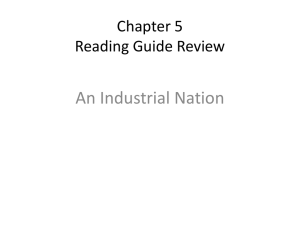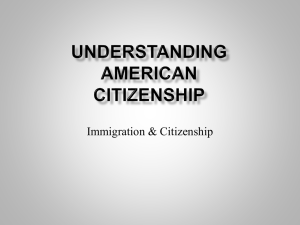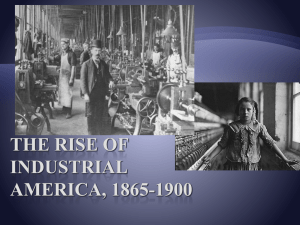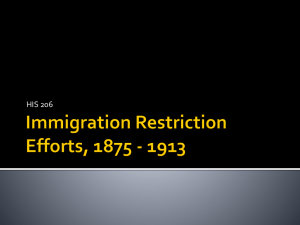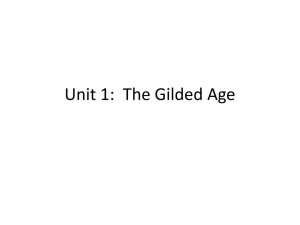The Growth of Big Business 1865-1900
advertisement
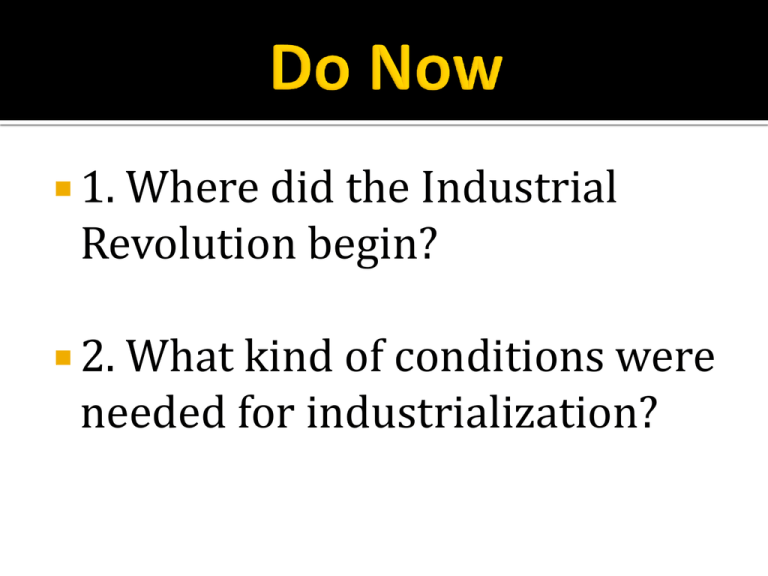
1. Where did the Industrial Revolution begin? 2. What kind of conditions were needed for industrialization? After the Civil War, the United States went through a period of industrialization Big businesses were formed, such as the banks, railroads, oil and coal companies Industrialization helped the U.S. grow, and many immigrants came to the U.S., but for workers life was very difficult As businesses grew, some began to develop ways to limit competition Carnegie Steel—founded in the 1870s by Andrew Carnegie Steel was used for railroads and skyscrapers Vertical Integration • Carnegie Steel used the vertical integration strategy to create a monopoly in the steel industry • Vertical integration is when a company owns all the factors of production (all the things you need to make a product) • Carnegie Steel could produce steel cheaper than his competitors Standard Oil Company— founded in the 1870s by John D. Rockefeller Originally produced kerosene as heating oil Today, the following companies used to make up Standard Oil: ExxonMobil Chevron BP Horizontal Integration Standard Oil gained a monopoly through horizontal integration • Horizontal Integration is when one company buys or takes over its competition • These monopolies were also known as trusts • Do Now Put your answers on ½ sheet of paper. You will hand this in for a quiz grade! 1. 2. Explain the difference between horizontal and vertical integration. Do you think monopolies are good or bad for America? Give examples to support your answer. Many industrial leaders viewed themselves in a positive way compared to everyone else They believed in “Social Darwinism” This idea means that those who get wealthy are better than those who don’t This idea justified laissezfaire capitalism Many industrialists, like Carnegie and Rockefeller, gained more wealth than they could ever spend They gained wealth by cutting costs in any way possible Low wages for workers Poor working conditions Unethical business practices They often became known as “Robber Barons” because of this Some industrial leaders also were known as “Captains of Industry” Carnegie, Rockefeller, Vanderbilt and others used much of their wealth to contribute to society They were considered “philanthropists” (people who give away their money” Vanderbilt University Carnegie Hall Rockefeller Center Rockefeller donated $450 million before he died Carnegie donated enough money for 2,500 libraries to be built 1. Explain why industrialists like Carnegie and Rockefeller would have supported the concept of Social Darwinism, while workers would have opposed it. 2. a) Compare and contrast vertical and horizontal integration. b) How did they lead to the creation of monopolies? Some industrialists thought their wealth should not be left to their descendants Andrew Carnegie wrote the “Gospel of Wealth” in 1889 Labor Union A group of workers who unite to improve their wages, working conditions and benefits They were created because of low wages and poor conditions in industry Workers had few rights and no protection from the government How did labor unions get better conditions, wages, etc? Collective bargaining Negotiations between the owners and workers Strikes Boycotts “Whether you're a union member or not, you have benefited from labor unions. They have set a national and local standard for working conditions, i.e., the 40-hour work week, the five-day work week, collective bargaining, fair grievance procedures, minimum wage, acceptable working conditions, insurance, retirement packages, sick leave, paid vacations and much more.” --Green Bay Gazette, February 28, 2011 List some of the benefits that all workers have gained as a result of labor unions. Two different types of labor unions emerged: 1. Unskilled Unions Unions that allowed all workers to join regardless of skill or profession Allowed women and African-Americans Knights of Labor 2. Skilled Unions Workers organized by their particular skill Ex. Carpenters, ironworkers The American Federation of Labor (AFL) Founded by Samuel Gompers in 1886 Haymarket Strike 1886 Homestead Strike 1892 Pullman Strike 1894 The government supported the owners, not the workers in labor disputes "In the first place, we should insist that if the immigrant who comes here in good faith becomes an American and assimilates himself to us, he shall be treated on an exact equality with everyone else, for it is an outrage to discriminate against any such man because of creed, or birthplace, or origin. But this is predicated upon the person's becoming in every facet an American, and nothing but an American...There can be no divided allegiance here. Any man who says he is an American, but something else also, isn't an American at all. We have room for but one flag, the American flag... We have room for but one language here, and that is the English language... and we have room for but one sole loyalty and that is a loyalty to the American people." 1. Do you think this quote is from A. before the Civil War B. after the Civil War C. the modern day 2. Why do you think it’s from the time period you chose above? 3. Which group of immigrants do you think this quote is about? This is a quote from Teddy Roosevelt in 1907 Do you think the quote reflects opinion towards immigrants today? For all the noise and anger that too often surrounds the immigration debate, America has nothing to fear from today’s immigrants. They have come here for the same reason that families have always come here– for the hope that in America, they could build a better life for themselves and their families. Like the waves of immigrants that came before them and the Hispanic Americans whose families have been here for generations, the recent arrival of Latino immigrants will only enrich our country --Barack Obama Immigration • Immigration – when people leave their own country for a new country Until the 1840s, most immigrants came from Northwest Europe (England, Scotland, etc) and Africa (forced because of slavery) From the 1840s to 1860s, there were many immigrants from Ireland (largely Catholic) Immigration Why did many immigrants come to the United States? • • Freedom Better job opportunities After the Civil War (1865-1914), millions of immigrants came to the U.S. Many came from Southern and Eastern Europe (Italy, Russia, the Balkans) and Asia (China) Many immigrants during this period experienced Nativism Nativism – discrimination by native-born Americans against immigrants 1850’sthe KnowNothing Party was created as an antiimmigrant political party (against Irish immigration) Why did nativism spread? Competition for factory jobs Lower wages Ethnic, cultural, and religious differences Fear of new ideas like socialism, communism, and anarchy Why would big business support more immigration? More workers Lower wages (cheap labor) Over 12 million immigrants came to the U.S. through Ellis Island At the turn of the century, why did most immigrants to the United States settle in cities? A. Jobs were readily available. B. Government relief programs required immigrants to settle in cities. C. Labor union leaders encouraged unrestricted immigration. D. Immigrants were not permitted to buy farmland. In the late 19th century, the pattern of United States immigration changed in that A. far fewer immigrants arrived in the United States than in previous years B. most immigrants chose to settle in the rural, farming regions of the western United States C. increasing numbers of immigrants came from eastern and southern Europe D. most immigrants were political refugees Urbanization – the movement of people from the country (rural) to the cities Why did people move to the cities? People moved to the cities because of the abundance of factory mobs Immigrants and farmers Political machines develop to help immigrants adjust to life in America Provide basic services (jobs, housing) in exchange for political support Political machines were very corrupt as a result Ex. Tammany Hall in NYC (Democrats) Urbanization led to other negatives Poor living conditions (tenement buildings) Unsanitary conditions (no running water, or sewage systems) led to disease Many reformers helped immigrants adjust to American life Jane Addams (Hull House) Create a chart that lists the positive and negative effects of urbanization in America during the Industrial Revolution



